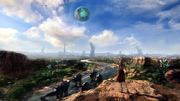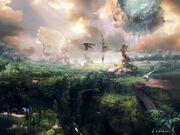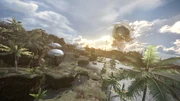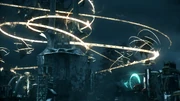Template:Sideicon Template:Sideicon Template:Sideicon Template:Locationlists
A world wild and fragile, vibrant and untamed. Gran Pulse. It's a placed ruled by the brutal struggle for survival, and the callous and uncaring whim of the fal'Cie. There is no such thing as mercy...only a never-ending string of trials that weed out the weak, and leave only the strong.
Vanille
Gran Pulse (グラン-パルス, Guran-Parusu?), also known simply as Pulse (下界, Parusu?, lit. Netherworld) to the citizens of Cocoon, is the world in Final Fantasy XIII and Final Fantasy XIII-2, and the artificial world of Cocoon floats in its atmosphere. Gran Pulse can be considered the parallel of Cocoon, as a world of natural evolution where animals and plants can grow to tremendous sizes. Director Motomu Toriyama has compared the size of Cocoon to that of North America, and Gran Pulse as similar in size as Earth.[1]
In Final Fantasy XIII, Gran Pulse features an open world design with a more free style of gameplay, a stark contrast to the linear experience of Cocoon. In Final Fantasy XIII-2, Gran Pulse is populated with many of Cocoon's former residents who had moved to the lowerworld, and built settlements.
Datalog

The vast untamed wilderness of Gran Pulse.
Template:See Also The savage world derives its name from that of the god Pulse. Its vast wilderness is populated by creatures ranging from the monstrous to the deadly, and its fal'Cie seem to have taken a decidedly less friendly approach toward human dealings than those of Cocoon, cultivating the land for settlement, but demonstrating little concern beyond that.
At one time in its history, Gran Pulse was home to a thriving civilization and many great cities. Now it is home to many great ruins, and people are nowhere to be seen.
Template:See Also The lowerworld, known as either 'Pulse' or 'Gran Pulse,' is an unforgiving wilderness infested with predatory monsters. This world once boasted a civilization that stood in conflict with Cocoon, but traces of its culture exist only in ruins.
Profile

Concept artwork of Gran Pulse.
The people of Cocoon are made to believe Gran Pulse is a living hell for humans. To remain in control, the Sanctum keeps the people of Cocoon in constant fear of a Pulsian invasion. This fear is strengthened by an event known as the War of Transgression, which tells of an army from Pulse attacking Cocoon many centuries ago. Cocoon's shell was cracked, and many Pulsian artifacts and warships are now found in areas near Cocoon's outer-rim like the Vile Peaks and the Hanging Edge.
In truth, the citizens of Gran Pulse were no different than the people of Cocoon, as they saw the floating world as the source of evil, fear, and eventual invasion. The fal'Cie of Cocoon would steal resources from Gran Pulse, and lure Pulsians to Cocoon with promises of an eternal paradise, increasing the hatred between the two worlds.
At the time of Final Fantasy XIII, the human civilization of Gran Pulse had nearly been wiped out, with lingering architecture its only living testament. The buildings of Yaschas Massif and Oerba suggest an advanced culture, though primitive in comparison to the highly advanced technology of Cocoon. It is unknown exactly how the humans on Pulse died out, but it is suggested many were transformed into l'Cie during the great war, and as a result the world of Pulse is populated by monsters and Cie'th. In Final Fantasy XIII Episode Zero -Promise- Part VII: Tomorrow, it is stated the fal'Cie deity Lindzei played a part in wiping out humanity.
During Final Fantasy XIII-2 it is revealed a nomadic tribe known as the Farseers, originally hailing from the ancient city of Paddra in Yaschas Massif, still live on Pulse and are lead by the seeress Yeul. As the only known survivors of the war, they avoid contact with modern civilization because they are aware of the prophecy that warns of potential conflicts between other humans and have chosen to never again use technology. The nomadic hunters of the Archylte Steppe in Final Fantasy XIII-2 are also thought by some to be descendants of the original inhabitants of Pulse.
According to Datalog entries, Gran Pulse was named after its creator, the Hallowed Pulse, who left many centuries ago entrusting the mission of perfecting the world to the fal'Cie. In contrast to Cocoon, the fal'Cie of Pulse are indifferent towards humanity, cultivating the land to support life with no concern beyond that. It is said, however, that the fal'Cie of Gran Pulse were the ones to construct the Arks, mysterious armories hidden across the land in preparation of a great battle.
Story
Final Fantasy XIII

People from Cocoon see Pulse for the first time.
When the six Pulse l'Cie reach the end of the Fifth Ark, they leave Cocoon for Gran Pulse in the hopes of finding a way to remove their brands. Setting up camp in the Vallis Media, they embark on a days long search for humans but to no avail. The party travels to Vanille and Fang's hometown of Oerba but find it empty and lifeless. After battling Barthandelus, the l'Cie return to Cocoon.
After Orphan's demise, Fang and Vanille sacrifice themselves to save the world from the Cocoon fal'Cie's scheme, and many of the surviving Cocoon inhabitants settle on Gran Pulse.
Final Fantasy XIII-2

New Bodhum.
In the three years since Cocoon's fall, survivors moved to Gran Pulse and built a small civilization near the base of the crystal pillar, and a small coastal town called New Bodhum. In Final Fantasy XIII-2 Fragments Before, it is revealed people can now use magic formerly exclusive to l'Cie, and several recent discoveries reveal people have been living on Gran Pulse until recently, contrary to popular belief they had been wiped out by the War of Transgression.
One night, a crystalline meteorite falls near New Bodhum, and monsters attack the village. When Serah is attacked, she is saved by Noel Kreiss, a Pulsian hunter from a doomed future who traveled through time to find her at her sister's request.
Serah and Noel set off to find Lightning in Valhalla and save the future. Using the Historia Crux, Noel and Serah visit some old and new locations on Pulse that show advancements in technology, such as Augusta Tower, and the futuristic metropolis of Academia, the city that began construction near Cocoon's crystal pillar in 3 AF.

Gran Pulse is turned into Nova Chrysalia.
After Noel and Serah reach Valhalla and defeat Caius, they return to year 500 AF in Academia. The chaos of Valhalla bursts from Etro's Gate and the new man-made Cocoon, called Bhunivelze, and all of Gran Pulse, are infected with chaos, the world transforming into Nova Chrysalia.
Lightning Returns: Final Fantasy XIII
Parts of Gran Pulse remain on Nova Chrysalia, that is gradually being eroded by the Chaos. In the Wildlands the ruins of Academia remain, and in the Dead Dunes is what remains of Archylte Steppe, dried up and turned into a desert. The man-made Cocoon Bhunivelze also remains, floating in Nova Chrysalia's atmosphere.
List of Areas
- Academia (XIII-2)
- Archylte Steppe (XIII, XIII-2)
- Augusta Tower (XIII-2)
- Dying World (XIII-2)
- Faultwarrens (XIII)
- Heaven's MountainsMentioned in XIII-2's Brain Blast quiz; their eruption led to the establishment of an event known as Volcano Day. (unvisitable)
- Mah'habara Subterra (XIII)
- Mt. FairneMentioned in XIII-2's Brain Blast quiz; the tallest mountain on Gran Pulse. (unvisitable)
- New Bodhum (XIII-2)
- Oerba (XIII, XIII-2)
- Sulyya Springs (XIII)
- Taejin's Tower (XIII)
- Vallis Media (XIII)
- Yaschas Massif (XIII, XIII-2)
Creation and Development
Square Enix promotional material describes the battles in Final Fantasy XIII as Cocoon being "scripted battles", compared to Gran Pulse as "random encounters".

Archylte Steppe 900 AF, concept art for Final Fantasy XIII-2.
Concept artworks for Final Fantasy XIII show a different Gran Pulse than the one in the game, with people among in the cities and flying vehicles. Final Fantasy XIII-2 Ultimania Omega reveals scrapped plans for the game. Cocoon's late capital Eden was planed to have crashed into either Oerba or Archylte Steppe. The scene of Eden in Archylte Steppe was to be in the distant future where the ancient capital of Cocoon would have been covered by vegetation.[2] Other conceptual artworks show Archylte Steppe 900 years after the ending of Final Fantasy XIII with a great city with high buildings, including a similar building to the government building of Eden in Final Fantasy XIII. This place would have had day and sunset versions.[2] The Thirteenth Ark was envisioned as a visitable location in the game, but in the final game is only seen hovering above Academia in the distance.[2]
Snow was planned a DLC episode where he would ride his Shiva Sisters motorbike across the Steppe while battling monsters.[2][3]
Gallery
Template:Gallery
Etymology
When the party arrives in Gran Pulse in Final Fantasy XIII, a locale introduction screen displays "Gran Pulse" with a subtitle Terra Incognita, which is Latin for "The Land of Unknown". The term Terra Incognita is also a term for a southern landmass on ancient world maps roughly located where Australia lies.
The Japanese kanji word used to notate the word "Pulse" in the Japanese version of Final Fantasy XIII, 下界, literally means "netherworld" or "underworld". Although these characters are usually pronounced together as Gekai, the staff of Final Fantasy XIII assigned these characters the custom, synthesized ateji reading of Parusu, the Japanese pronunciation of the English word "Pulse".
Trivia
- Some original inhabitants of Gran Pulse have their names in a different form from those on Cocoon. On Cocoon, names are written in the personal name, family name format common in many individualistic societies, while on Gran Pulse, names use a format common in collectivist societies with the area in which the person hails from first, and then both their clan (family) name and personal names after. Two examples are Oerba Dia Vanille ("Vanille of the Dia clan, from the village of Oerba") and Paddra Nsu-Yeul ("Yeul of the Nsu clan, from the nation of Paddra"). Two notable exceptions are Noel Kreiss and Caius Ballad, whose names are in the form used by the people of Cocoon.
References
- ↑ Motomu Toriyama in Dengeki PlayStation interview.
- ↑ 2.0 2.1 2.2 2.3 http://squareportal.net/2012/07/16/final-fantasy-xiii-2-cancelled-environments-areas-and-dlc-plans/
- ↑ Final Fantasy XIII-2 Ultimania Omega Director and Producer Interviews
Template:FFXIII Template:XIII2
